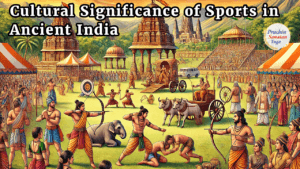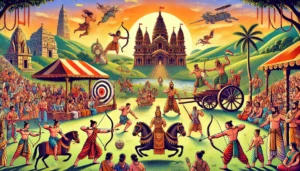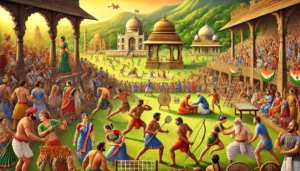
Cultural Significance of Sports in Ancient India
Cultural Sports in Ancient India
Sports have always played an integral role in human culture, fostering community, health, and competition. In ancient India, sports were not simply recreational activities but instead, they were deeply ingrained in traditions, epics, and festivals, reflecting the values, philosophies, and way of life of society. The legacy of these sports continues to serve as inspiration for contemporary practices and traditions.
“Sports in Ancient Indian Traditions”
Physical fitness, mental resilience, and spiritual growth were emphasized by ancient Indian traditions. Sports and physical activities were considered essential for holistic development. The importance of physical training and martial arts is highlighted by texts like the Dhanurveda, an ancient treatise on archery and warfare. Practices like yoga, often categorized under spirituality, are a prime example of how physical discipline and mindfulness were integrated into everyday life.
Sports such as wrestling (mallayuddha), archery (dhanurvidya), horse riding, and chariot racing were widely practiced and celebrated. These activities prepared individuals for warfare while promoting physical strength and agility. Competitions often took place in public arenas, bringing together communities and showcasing the athletes’ prowess.
“Sports in Epics: The Mahabharata and Ramayana”
The great Indian epics, Mahabharata and Ramayana, mention sports and physical competitions extensively.
Ramayana :
In the Ramayana, heroism and valor are often linked to sports and physical strength. The breaking of Shiva’s bow during Sita’s swayamvara by Lord Rama demonstrates unparalleled physical and mental strength. Similarly, feats such as jumping across oceans and uprooting mountains by Hanuman can be seen as symbolic of ancient sportsmanship, blending physical ability with divine inspiration.
Mahabharata :
Numerous instances of physical competitions are narrated in the Mahabharata. For example, one of the most iconic examples is the archery contest during Draupadi’s swayamvara. Arjuna’s mastery of the bow not only exemplifies physical skill but also showcases his focus and precision.
Another significant episode in the epic is the display of martial arts by the Kauravas and Pandavas under the guidance of Guru Dronacharya. The tournament demonstrated their prowess in archery, sword fighting, and wrestling, highlighting the importance of sports in preparing warriors for their duties.
Table of Contents

Cultural Sports in Ancient India
“Sports in Festivals”
Festivals in ancient and modern India have long celebrated sports as a form of communal joy and spiritual expression.
Kusti and Local Wrestling Matches :
During local festivals in many rural parts of India, traditional wrestling matches are organized. These matches are not only showcased physical strength but also serve as a platform to preserve ancient traditions and bring communities together.
Pongal and Jallikattu :
During Pongal, people in Tamil Nadu celebrate a harvest festival that includes the traditional sport of jallikattu (bull-taming), which is a prominent feature. This sport showcases courage, teamwork, and the special bond between humans and animals.
Onam and Vallamkali :
In Kerala, people celebrate the festival of Onam by participating in the famous vallamkali (boat race). During this event, teams of rowers come together to synchronize their efforts in beautifully decorated boats, combining the spirit of competition with unity.
“Symbolism and Cultural Impact”
In ancient Indian culture, sports were not just physical activities; they symbolized deeper philosophical values. The principles of dharma (righteousness) and karma (action) were reflected in sports, with a focus on discipline, teamwork, and fair play. Sports also promoted social harmony, as people from different strata of society participated and celebrated together.
Moreover, these activities were often imbued with spiritual significance. For instance, many martial arts and physical disciplines had roots in temple traditions, linking physical fitness to devotion and spirituality.
In general, it can be said that,
The cultural significance of sports in ancient India was transcended by mere physical exercise. They were interwoven into the fabric of traditions, epics, and festivals, serving as a medium for physical excellence, moral lessons, and communal unity. The enduring legacy of these sports is continued to be influenced by modern practices, reminding us of their timeless relevance and the values they embody.
By actively engaging in the practice and preservation of these traditions, we not only celebrate our rich heritage but also cultivate important values such as discipline, resilience, and harmony that have been passed down through generations by these ancient sports.

Cultural Sports in Ancient India
FAQs on Cultural Significance of Sports in Ancient India: Traditions, Epics, and Festivals
1. What role did sports play in ancient Indian society?
Sports in ancient India were integral to daily life and held both recreational and religious significance. They were not only a form of physical exercise but also a means of developing discipline, strength, and valor. Many sports were linked to religious rituals and festivals, symbolizing cultural values and community bonding.
2. What are some traditional sports mentioned in ancient Indian texts?
Ancient Indian texts, such as the Vedas, the Mahabharata, and the Ramayana, mention various traditional sports like archery (Dhanurvidya), wrestling (Malla-yuddha), chariot racing (Rathayatra), and dice games (Aksha). These sports were often depicted as skills required by warriors and nobles.
3. How were sports connected to religious festivals in ancient India?
Many sports were part of religious festivals and celebrations. For instance, wrestling matches were often held during festivals dedicated to deities like Lord Krishna. The Rathayatra festival, associated with Lord Jagannath, involved grand chariot processions and races. Such events fostered communal harmony and were seen as offerings to the gods.
4. What is the significance of sports in Indian epics like the Mahabharata and Ramayana?
In the Mahabharata and Ramayana, sports and physical prowess are central to the narratives. Characters like Arjuna excel in archery, while Bhima is known for his strength in wrestling. These epics highlight the importance of sports in demonstrating heroism, skill, and moral values.
5. How did ancient Indian sports influence modern sports?
Many ancient Indian sports laid the foundation for modern games. For example, chess (Chaturanga) originated from ancient Indian board games. Traditional martial arts like Kalaripayattu have influenced modern combat sports. The emphasis on discipline and physical fitness continues to inspire contemporary sports culture.
6. Were there any sports specifically for women in ancient India?
While ancient Indian society was predominantly patriarchal, there is evidence that women participated in certain sports and physical activities. Texts and sculptures depict women engaging in activities like archery and ball games, often during festivals and recreational gatherings.
7. How were sports organized and managed during ancient times?
Sports in ancient India were often organized as part of royal courts, religious festivals, and public gatherings. Kings and nobles patronized athletes and organized competitions. Temples and local communities also played a role in promoting sports through festivals and rituals.
8. What was the significance of physical fitness and sports in ancient Indian education?
Physical fitness and sports were integral to the Gurukul system of education. Students were trained in various physical activities, including yoga, wrestling, and archery, to develop their physical, mental, and spiritual well-being. This holistic approach aimed at creating well-rounded individuals.
9. How did ancient Indian sports contribute to social cohesion?
Sports in ancient India acted as a unifying force, bringing people from different castes and communities together. Festivals and sports events provided a platform for social interaction, fostering a sense of unity and shared cultural identity.
10. Are any ancient Indian sports still practiced today?
Yes, several ancient Indian sports are still practiced today, either in their original or evolved forms. Wrestling, archery, and martial arts like Kalaripayattu continue to be popular. Traditional games like Kabaddi and Kho-Kho have gained international recognition and are played competitively.
Summary
Sports in ancient India held significant cultural, social, and spiritual importance, deeply embedded in the fabric of daily life, religious practices, and the philosophical outlook of the people. The traditions, epics, and festivals of ancient India offer a rich tapestry that highlights the role of sports as more than mere physical activities.
Traditions and Practices
Sports and physical activities in ancient India were closely linked to the holistic development of individuals, emphasizing physical fitness, mental acuity, and moral discipline. Various traditional sports like wrestling (Malla-Yuddha), archery (Dhanurvidya), and chariot racing were not only forms of entertainment but also crucial for preparing warriors for battle. These sports were often taught in gurukuls (ancient educational institutions) as part of the overall curriculum that aimed at developing well-rounded individuals.
Wrestling was particularly popular, symbolizing strength and endurance. It was practiced in akharas (wrestling schools), where wrestlers adhered to strict diets and rigorous training routines. Archery, on the other hand, was revered for its spiritual and martial significance, often associated with the warrior class (Kshatriyas). Chariot racing, an aristocratic sport, showcased the skills of warriors and was a prominent feature in royal courts and public spectacles.
Epics and Literature
The great Indian epics, the Mahabharata and the Ramayana, are replete with references to sports and physical prowess. Characters like Arjuna and Bhima from the Mahabharata exemplify mastery in archery and wrestling, respectively. The epics highlight the importance of physical strength, skill, and moral character in the context of dharma (duty) and societal roles.
In the Mahabharata, the dice game played by the Pandavas and Kauravas symbolizes not just entertainment but also a philosophical contemplation of fate and free will. Similarly, the Ramayana describes the youthful sports and martial training of Lord Rama and his brothers, emphasizing the role of sports in shaping virtues like discipline, courage, and honor.
Festivals and Cultural Celebrations
Sports were integral to various festivals and religious ceremonies, reflecting the communal and celebratory aspects of ancient Indian society. Festivals like Makara Sankranti and Onam featured traditional games and contests, fostering community spirit and joy.
The Kumbh Mela, a major religious gathering, historically included wrestling matches and other physical contests, reinforcing the connection between physical prowess and spiritual growth. Similarly, rural festivals often featured indigenous games like kabaddi and kho-kho, promoting unity and cultural heritage.
Spiritual and Philosophical Context
In ancient India, sports were not just physical pursuits but were imbued with spiritual significance. The concept of yoga, which includes physical postures (asanas), was developed as a means to achieve spiritual enlightenment and physical well-being. This holistic approach underscores the integration of body, mind, and spirit, which is a recurring theme in Indian philosophy.
The Bhagavad Gita, a spiritual text from the Mahabharata, uses metaphors of archery and war to convey deeper philosophical truths about life, duty, and self-realization. This illustrates how sports and physical activities were often seen as metaphors for life’s larger battles and challenges.
Conclusion
The cultural significance of sports in ancient India is deeply intertwined with its traditions, epics, and festivals. Sports served as a medium for physical development, moral education, and community bonding, reflecting the holistic view of life prevalent in ancient Indian society. The legacy of these sports and their underlying values continue to influence modern Indian culture, emphasizing the timeless relevance of physical activities in shaping character and promoting societal harmony.
Related Articles
- Restful Nights: Ayurvedic Remedies and Traditional Indian Practices to Overcome Insomnia and Late-Night Habits
- The Tridevi: Lakshmi, Saraswati, and Parvati – Their Roles and Powers
- “Divine Creatures of Ancient Indian Scriptures: Exploring the Role of Animals in the Vedas, Puranas, and Mahabharata”
- Nature and Spirituality: Exploring the Sacred Essence of the Himalayas, Ganga, and Other Natural Wonders”
- “Reviving the Gurukul System: Relevance and Lessons for Modern Education”
- “Exploring Greek and Indian Mythology: Similarities Between Greek and Indian Mythology “
- “Embracing Sattvic Living: Harmonizing Mind, Body, and Soul Through Food and Lifestyle”
- “Charity and Prosperity: Exploring the Concept of Daan and Its Financial Relevance in Modern Life”
- How to Build an Eco-Friendly Home Inspired by Vastu Shastra
- Comparison of Ancient and Modern Sports: How Traditional Sports Have Influenced Contemporary Games
- “Timeless Lessons from Ancient Tales: Linking Samudra Manthan and Ganga’s Descent to Modern Ecological Challenges”
- “Reviving Sanskrit: How AI is Preserving Ancient Languages for the Future”
- “Mathura: The Sacred Land of Lord Krishna’s Divine Leelas”
- Investing for Future Generations: Lessons from Indian Traditions on Legacy Building and Wealth Preservation
- “Ancient Indian Wisdom: Timeless Lessons for Tackling Today’s Climate Crisis”
- “Artificial Intelligence and Spirituality: Transforming Ancient Practices for the Modern World”
- “Gold and Real Estate in India: Timeless Assets Shaping Financial Strategies”
- Tradition Meets Innovation: The Evolution of Technology in Hindu Rituals
- End-of-World Myths: Exploring Kali Yuga in Hinduism and Ragnarök in Norse Mythology
- Garuda, Pegasus, and Dragons: The Universal Ties of Mythical Beasts Across Cultures
- “Ancient Vimanas: Mythical Flying Machines or Evidence of Advanced Technology?”
- Time Travel in Hindu Mythology: The Fascinating Tales of Kakudmi and King Raivata
- “Divine Feminine Power in Hindu Mythology: The Legends of Durga, Saraswati, and Lakshmi”
- “Divine Beings of Sanatan Dharma: The Spiritual Significance of Sacred Animals in Hinduism”
- “Symbolism in Mythological Art: Unlocking Hidden Meanings in Ancient Temple Carvings”
- “Exploring Technological Advancements in Ancient India and Civilizations: Vimana, Metallurgy, & Water Management systems”
- Unveiling the Mysteries: Ancient Temples of Sanatan Dharma , Mysterious Temples of India
- “The Scientific Knowledge of Sanatan Dharma: Ancient Wisdom Meets Modern Science”
- Ancient Indian Sports and Games: Celebrating a Legacy of Skill, Strength & Strategy”
- “Exploring the Cosmic Link: The Connection Between Astronomy and Vedic Astrology”
- The Power of Sanskrit: Unlocking the Divine Language of the Gods
- “The End of Kaliyuga: A Sanatan Insight into the World’s Final Chapter”
- Explore more articles on Prachin Sanatan Yuga.
Cultural Sports in Ancient India Cultural Sports in Ancient India Cultural Sports in Ancient India Cultural Sports in Ancient India Cultural Sports in Ancient India Cultural Sports in Ancient India Cultural Sports in Ancient India Cultural Sports in Ancient India
The cultural significance of sports in ancient India was transcended by mere physical exercise. They were interwoven into the fabric of traditions, epics, and festivals, serving as a medium for physical excellence, moral lessons, and communal unity. The enduring legacy of these sports is continued to be influenced by modern practices, reminding us of their timeless relevance and the values they embody.
The cultural significance of sports in ancient India is deeply intertwined with its traditions, epics, and festivals. Sports served as a medium for physical development, moral education, and community bonding, reflecting the holistic view of life prevalent in ancient Indian society. The legacy of these sports and their underlying values continue to influence modern Indian culture, emphasizing the timeless relevance of physical activities in shaping character and promoting societal harmony.
In ancient Indian culture, sports were not just physical activities; they symbolized deeper philosophical values. The principles of dharma (righteousness) and karma (action) were reflected in sports, with a focus on discipline, teamwork, and fair play. Sports also promoted social harmony, as people from different strata of society participated and celebrated together.
The Kumbh Mela, a major religious gathering, historically included wrestling matches and other physical contests, reinforcing the connection between physical prowess and spiritual growth. Similarly, rural festivals often featured indigenous games like kabaddi and kho-kho, promoting unity and cultural heritage.
Cultural Sports in Ancient India Cultural Sports in Ancient India Cultural Sports in Ancient India Cultural Sports in Ancient India Cultural Sports in Ancient India Cultural Sports in Ancient India Cultural Sports in Ancient India Cultural Sports in Ancient India
Cultural Sports in Ancient India Cultural Sports in Ancient India Cultural Sports in Ancient India Cultural Sports in Ancient India Cultural Sports in Ancient India Cultural Sports in Ancient India Cultural Sports in Ancient India Cultural Sports in Ancient India

mace fighting is one of the favourites , jai shree krishna 🕉️
जय श्री कृष्ण 🙏